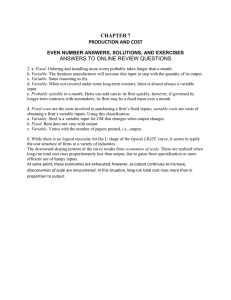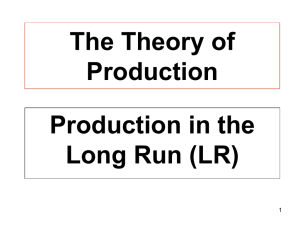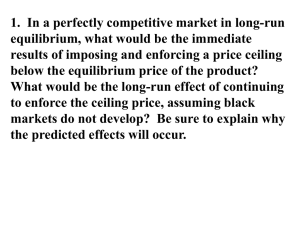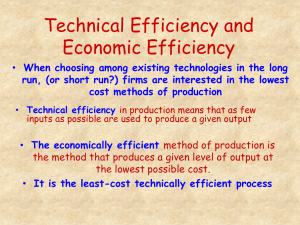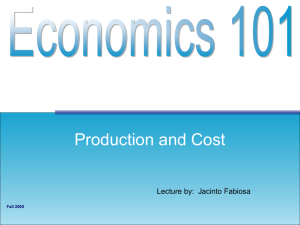Production In The Long Run
advertisement
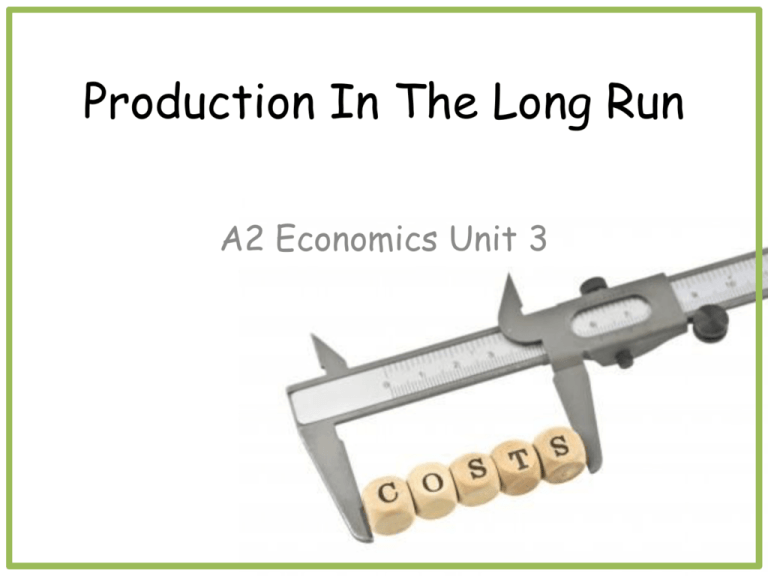
Production In The Long Run A2 Economics Unit 3 Aims and Objectives Aim: • Understand long run production. Objectives: • Define increasing and decreasing returns to scale. • Explain how optimal output can change. • Analyse the effects of economies of scale. • Evaluate short run costs and long run costs. Starter • Define marginal cost. • Define average total cost. • Explain how the law of diminishing returns works. Production in Long Run • In the long run a firm can temporarily overcome dim.ret. as it can vary its fixed factors. • E.g. it could move to a larger premises. • But dim.ret. sets in again when the premises get too small –overloaded. • Occurs beyond optimal output. Optimal Output Changing ATC Per Unit £s ATC ATC1 ATC2 0 A B ATC3 Output Diagram Explained • Different combination of fixed and variable factors. • Separate SR ATC curve for every level of output. • Firm producing at output 0A is producing at lowest point on ATC. • 0B high level of output with lower costs. Increasing Returns to Scale • At each SR ATC curve increasing returns to scale are occurring. • Due to the ability of firms to increase all factors of production. • Therefore in the LR there are no fixed factors! • Where an increase in factor inputs leads to a more than proportionate increase in outputs. LRATC Curve – Falling LR Costs LRATC Per Unit £s ATC ATC1 ATC2 ATC3 • Increasing returns to scale. • LRATC slopes downwards due to economies of scale. LRATC 0 Output Economies of Scale • Returns to scale only occurs up to a point. Economies of Scale Diseconomies of Scale LRATC LRATC Per Unit £s LRATC 0 MES Output Decreasing Returns to Scale • Where an increase in factor inputs leads to a less than proportionate increase in factor outputs. • Results in diseconomies of scale. Constant Returns to Scale • Where an increase in factor inputs leads to a proportional increase in factor outputs. LRATC Per Unit £s Economies of Scale Diseconomies of Scale Constant Returns to Scale LRATC 0 A B Output Minimum Efficient Scale • This is the lowest point on the LRATC curve and also shows productive efficiency. • Firms that cannot meet the MES are unlikely to be competitive with other firms. Questions • Why can you now buy a high-performance laptop for just a few hundred pounds when a similar computer might have cost you over £2,000 just a few years ago? • Why is the average price of digital cameras falling all the time whilst the functions and performance level are always on the rise? • How can IKEA profitably sell flat-pack furniture at what seem impossibly low prices? Answer • ECONOMIES OF SCALE • MORE FIRMS REACHING THEIR MES! Short Run Vs Long Run Unit Cost £ SRATC SRATC1 LRATC 0 A B Output Diagram Explained • Firm producing at 0A lowest point on SRATC curve. • Firm increases output to 0B perhaps due to an unexpected rise in demand. • Costs increase up the SRATC curve due to ‘overloading’. Diagram Explained • Firm decides to increase its fixed factors. • Firm moves to SRATC1, until it reaches LRATC at point 0B. • Productive Efficiency. Plenary 1) Construct a diagram to explain how a firm might react to a substantial increase in the demand for its product. 2) Explain in terms of the diagram how the firm could overcome the problems it now faces.
